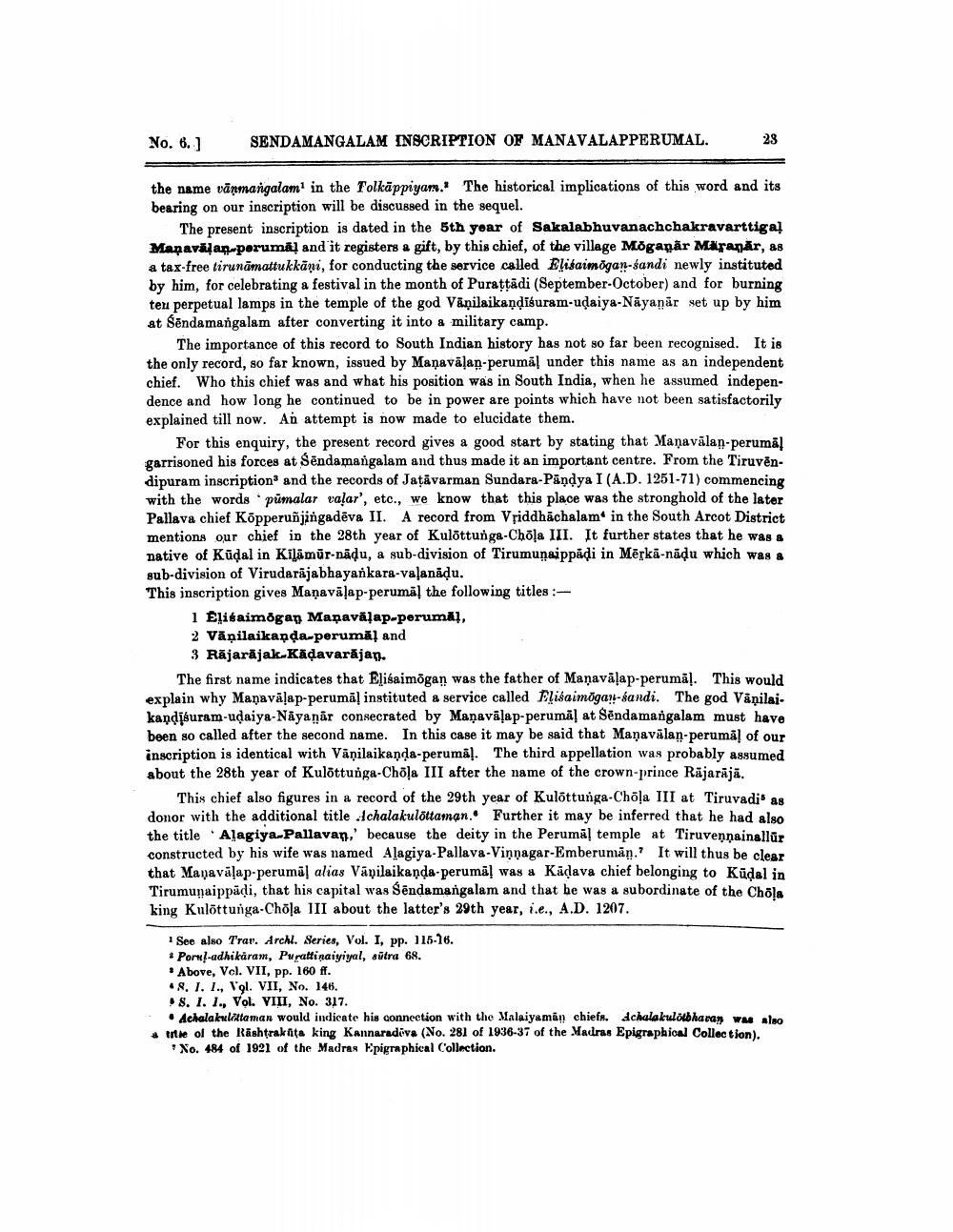________________
No. 6.]
SENDAMANGALAM INSCRIPTION OF MANAVALAPPERUMAL.
the name vanmangalam1 in the Folkäppiyam. The historical implications of this word and its bearing on our inscription will be discussed in the sequel.
28
The present inscription is dated in the 5th year of Sakalabhuvanachchakravarttigal Manavajan-perumal and it registers a gift, by this chief, of the village Moganär Märanär, as a tax-free tirunamattukkāņi, for conducting the service called Elisaimogan-sandi newly instituted by him, for celebrating a festival in the month of Puraṭṭādi (September-October) and for burning ten perpetual lamps in the temple of the god Vänilaikandisuram-udaiya-Nayaṇar set up by him at Sendamangalam after converting it into a military camp.
The importance of this record to South Indian history has not so far been recognised. It is the only record, so far known, issued by Manavalan-perumal under this name as an independent chief. Who this chief was and what his position was in South India, when he assumed independence and how long he continued to be in power are points which have not been satisfactorily explained till now. An attempt is now made to elucidate them.
For this enquiry, the present record gives a good start by stating that Manavalaṇ-perumāļ garrisoned his forces at Sendamangalam and thus made it an important centre. From the Tiruvendipuram inscription3 and the records of Jaṭavarman Sundara-Pandya I (A.D. 1251-71) commencing with the words pumalar valar', etc., we know that this place was the stronghold of the later Pallava chief Kōpperuñjingadeva II. A record from Vriddhachalam in the South Arcot District mentions our chief in the 28th year of Kulottunga-Chōla III. It further states that he was a native of Kūḍal in Kilāmur-nādu, a sub-division of Tirumuṇaippadi in Mēṛkā-nāḍu which was a sub-division of Virudarajabhayankara-valanādu.
This inscription gives Maṇavalap-perumal the following titles:
1 Elisaimōgan Maṇavälap-perumāļ,
2 Vāṇilaikaṇḍa-perumāļ and
3 Rājarājak-Kāḍavarājaṇ.
The first name indicates that Elisaimōgan was the father of Maṇavāļap-perumāļ. This would explain why Manavalap-perumal instituted a service called Elisaimogan-sandi. The god Vanilaikandisuram-udaiya-Nayanar consecrated by Manavalap-perumal at Sendamangalam must have been so called after the second name. In this case it may be said that Maṇavalan-perumal of our inscription is identical with Vāņilaikaṇḍa-perumal. The third appellation was probably assumed about the 28th year of Kulottunga-Chōla III after the name of the crown-prince Rājarājā.
This chief also figures in a record of the 29th year of Kulottunga-Chōla III at Tiruvadi as donor with the additional title Achalakulöttaman. Further it may be inferred that he had also the title Alagiya-Pallavan,' because the deity in the Perumal temple at Tiruveņņainallur constructed by his wife was named Alagiya-Pallava-Vinnagar-Emberuman. It will thus be clear that Manavalap-perumal alias Vāņilaikanda-perumal was a Kaḍava chief belonging to Kūḍal in Tirumunaippadi, that his capital was Sendamangalam and that he was a subordinate of the Chōla king Kulottunga-Chola III about the latter's 29th year, i.e., A.D. 1207.
1 See also Trav. Archl. Series, Vol. I, pp. 115-16.
* Porul-adhikaram, Purattinaiyiyal, sūtra 68.
Above, Vel. VII, pp. 160 ff.
8. I. I., Vol. VII, No. 146.
S. I. 1., Vol. VIII, No. 317.
• Achalakulittaman would indicate his connection with the Malaiyaman chiefs. Achalakulötbhavan was also
a title of the Rashtrakuta king Kannaradeva (No. 281 of 1936-37 of the Madras Epigraphical Collection). No. 484 of 1921 of the Madras Epigraphical Collection.




